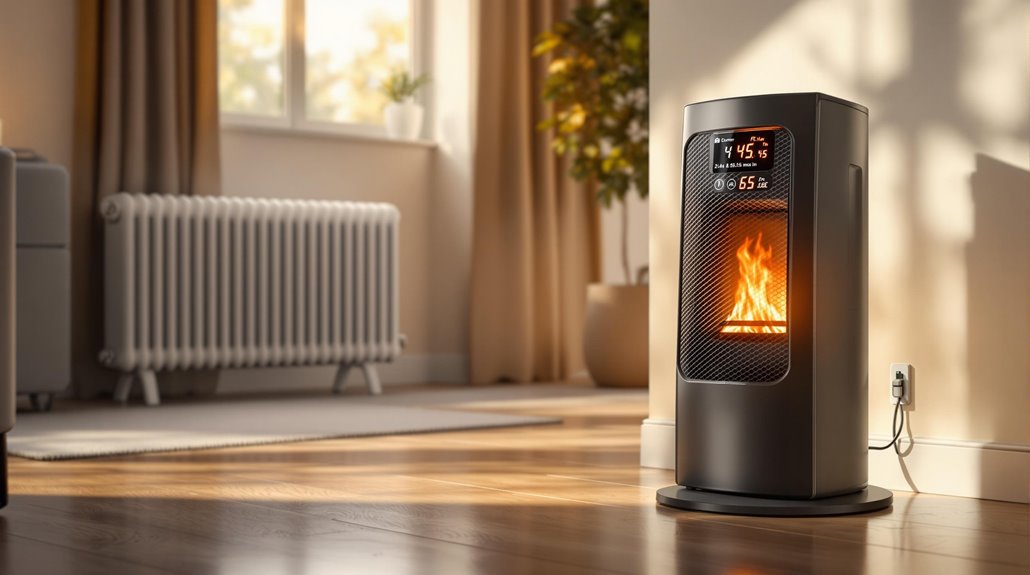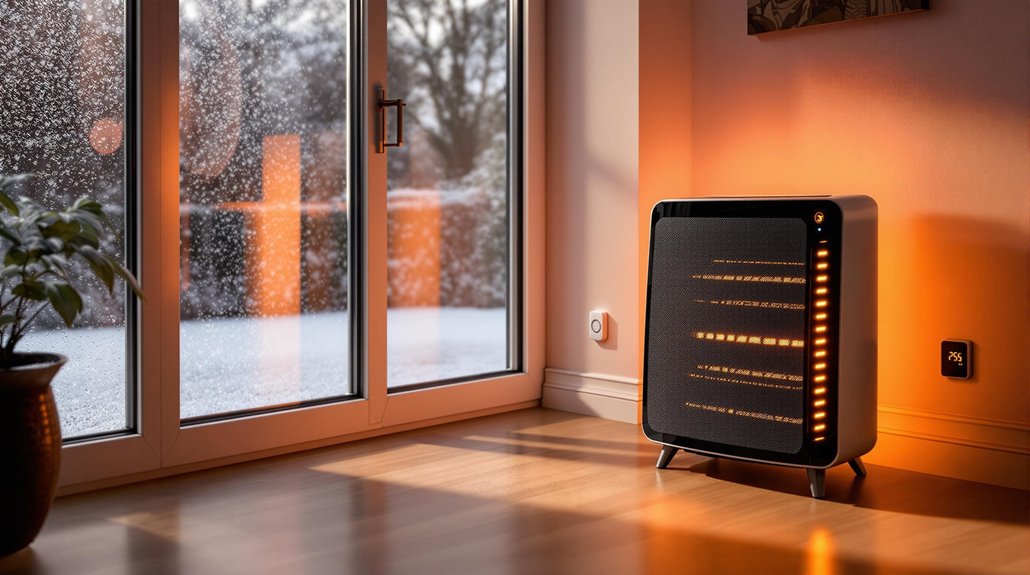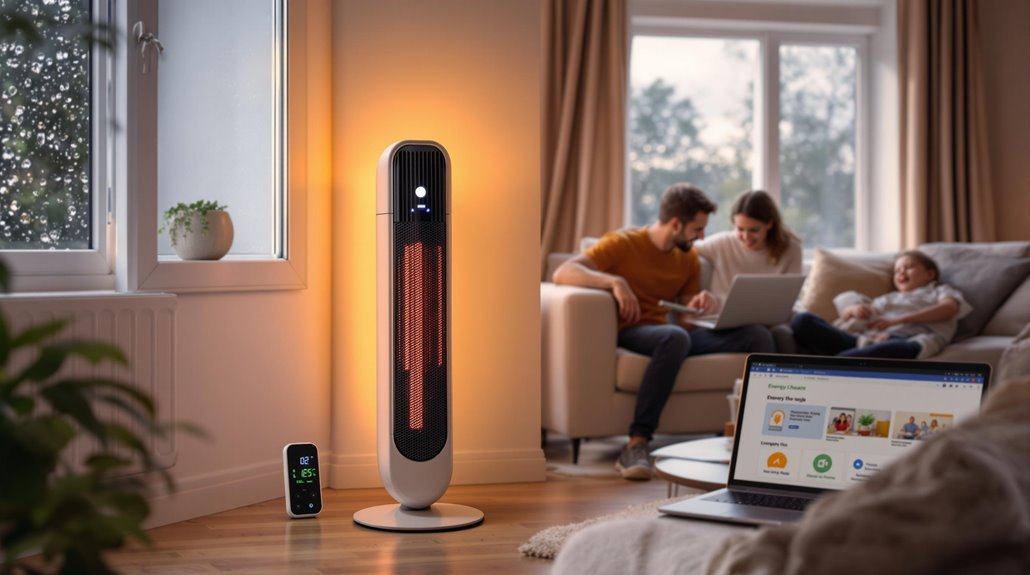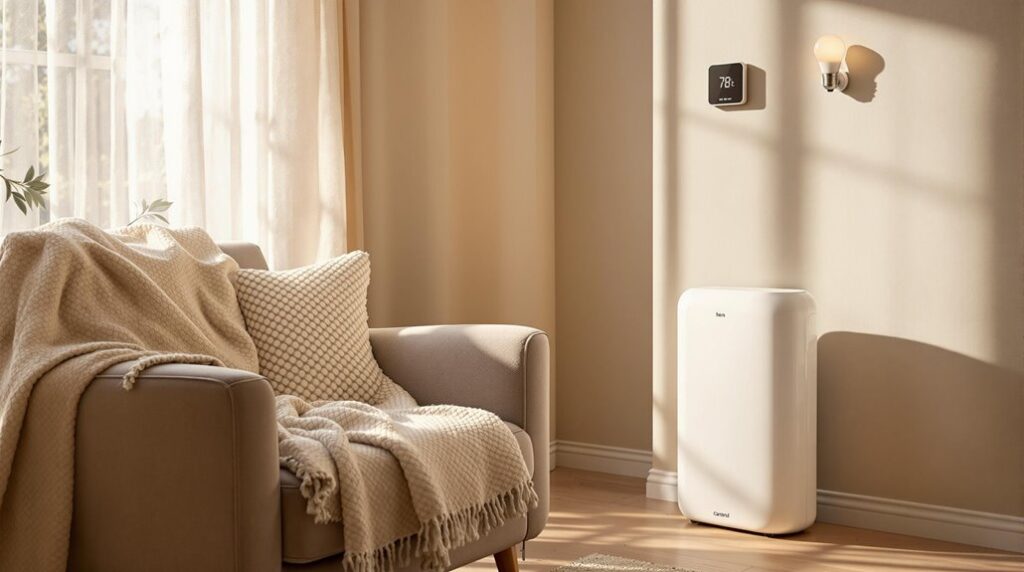I’ve been analyzing ceramic heater running costs, and here’s what you need to know: at current UK energy prices, a 1500W ceramic heater costs approximately 40.5p per hour to operate. That’s not exactly pocket change, but there’s more to this story than the headline figure suggests. The real question isn’t just about upfront costs—it’s about efficiency, smart usage patterns, and how these factors combine to impact your monthly electricity bill in ways you might not expect.
Key Takeaways
- Ceramic heaters cost 40.5p per hour at 1500W, making them mid-range compared to cheaper infrared (4p) and expensive convector heaters (54p).
- Over 99% energy conversion efficiency and self-regulating PTC ceramic material prevent overheating while enabling targeted zone heating for cost savings.
- Using eco-mode, timers, and maintaining 18-20°C thermostat settings can reduce energy consumption by 10-30% when lowering central heating.
- Monthly costs reach £97.20 for 8 hours daily usage, but smart thermostats and proper positioning significantly reduce unnecessary heating expenses.
- Enhance efficiency by sealing drafts, using thermal curtains to reduce heat loss by 25%, and maintaining 1m clearance around heaters.
Running Costs of Ceramic Heaters Vs Other Electric Heaters

When comparing electric heater running costs, ceramic heaters occupy a middle ground that’s often misunderstood by consumers. I’ve calculated the hourly costs based on current UK electricity rates of 27p per kWh, and here’s what you need to know.
Ceramic heaters typically cost 40.5p per hour to run at 1500W. That’s more expensive than infrared heaters at just 4p hourly, but considerably cheaper than convector heaters which’ll cost you 54p per hour. Fan heaters run at 20.25p hourly, while halogen heaters cost 32.4p.
What makes ceramics worthwhile isn’t just the running cost—they’re more efficient at heating spaces quickly, potentially reducing your actual usage time compared to lower-wattage alternatives. Modern ceramic heaters often include built-in thermostats that automatically regulate temperature, helping to optimize energy consumption and reduce overall heating costs.
Energy Efficiency Benefits of Ceramic Heating Elements
Beyond the hourly running costs, ceramic heating elements deliver impressive energy efficiency that directly impacts your electricity bills. I’ve found that ceramic heaters convert over 99% of electrical energy into heat, minimizing waste compared to other heating methods. The PTC ceramic material self-regulates temperature, preventing energy-draining overheating cycles that plague standard heaters.
What sets ceramic heaters apart is their rapid heat-up capability and targeted zone heating. You’ll warm specific rooms instead of heating your entire home, cutting energy consumption by 10-30% when paired with lowered central heating. The aluminum fins maximize heat distribution while retaining warmth after shutdown, reducing runtime. The robust construction with high-quality alumina ensures consistent performance even in challenging home environments with varying humidity levels.
This efficient design means you’re getting maximum heating output for every penny spent on electricity.
Factors That Impact Your Ceramic Heater Electricity Bills

Several key factors determine how much your ceramic heater adds to your monthly electricity bill, with wattage serving as the primary cost driver. I’ve found that a 1500W model doubles the energy consumption of a 750W unit, using 1.5 kWh hourly. Your usage duration multiplies costs linearly—running a heater three hours daily adds roughly 90 kWh monthly.
Local electricity rates greatly impact expenses, with UK rates varying between 24-30p per kWh across regions. I recommend checking your specific tariff, as higher rates amplify bills regardless of heater efficiency. Additionally, heating system efficiency can significantly influence overall costs, making it essential to choose an effective heating solution.
Thermostat settings matter tremendously. Each 1°C increase raises energy use by approximately 10%. I’ve discovered that maintaining 18-20°C optimises both comfort and costs, while programmable thermostats reduce unnecessary usage when you’re away. Proper draft sealing around windows and doors prevents heat loss, allowing your ceramic heater to maintain warmth more efficiently.
Money-Saving Tips for Operating Ceramic Heaters
Once you understand the factors driving your ceramic heater’s electricity costs, implementing targeted strategies can greatly reduce your monthly bills without sacrificing comfort. I recommend engaging eco-mode to automatically adjust heat output and setting timers for occupied hours only. You’ll save approximately 10% on heating costs for each 1°C reduction, so maintain thermostats at 18-20°C rather than higher settings.
Strategic placement matters considerably. Position your heater centrally, away from draughts, with 1m clearance from walls and furniture. I’ve found that elevating units off carpets prevents blocked intake vents. Consider ceramic heaters for their superior heat retention capabilities, as they continue warming your space even after being switched off.
Complement these practices with thermal curtains, which reduce window heat loss by 25%, and monthly vent cleaning to maintain efficient airflow performance.
Real-World Cost Calculations for UK Households

When calculating actual running costs for your ceramic heater, you’ll need to factor in the current UK electricity rate of £0.27 per kWh under April 2025’s Price Cap. I’ll show you exactly what you’re looking at cost-wise.
Your typical 1500W ceramic heater costs £0.405 per hour to run. If you’re using it for 8 hours daily, that’s £3.24 per day or £97.20 monthly. Compare this to other heaters you might consider: infrared models cost just £9.60 monthly, while convector heaters reach £120.00.
Here’s what affects your actual bills: room insulation quality, thermostat settings, and usage patterns. Poor insulation means longer runtime. Smart thermostats and timers can slash these costs considerably by preventing unnecessary heating when you’re away. Low-wattage heaters may struggle with heating capacity in larger rooms, requiring longer operating times that actually increase your total energy consumption.
Conclusion
I’ve shown you ceramic heaters cost around 40.5p per hour to run, making them pricier than infrared alternatives. However, their 99% efficiency rate means you’re getting excellent heat conversion for your money. You’ll maximize savings by setting thermostats to 18-20°C, using timers strategically, and improving your home’s insulation. While ceramic heaters aren’t the cheapest option, they’re highly effective for targeted heating when operated correctly.
References
- https://www.idealhome.co.uk/house-manual/heating/ceramic-heater-vs-fan-heater-which-is-best
- https://www.sust-it.net/price-comparison-electric/&type=ceramic-heaters
- https://forums.moneysavingexpert.com/discussion/6419327/is-a-halogen-or-ceramic-heating-more-cost-effective-to-run-in-a-single-room
- https://www.perchenergy.com/energy-calculators/space-heater-electricity-use-cost
- https://www.morrisdirect.co.uk/blogs/advice-centre-tubular-heaters/everything-you-need-to-know-about-1p-per-hour-electric-heaters
- https://www.sust-it.net/heating-energy-calculator.php
- https://www.daewooelectricals.com/blog/what-is-the-cheapest-electric-heater-to-run/
- https://homeguide.com/costs/cost-to-run-a-space-heater
- https://elegant-radiators.co.uk/blogs/news/are-ceramic-heaters-cheap-to-run
- https://www.dxmht.com/article/ceramic-heating-element-applications-benefits.html

